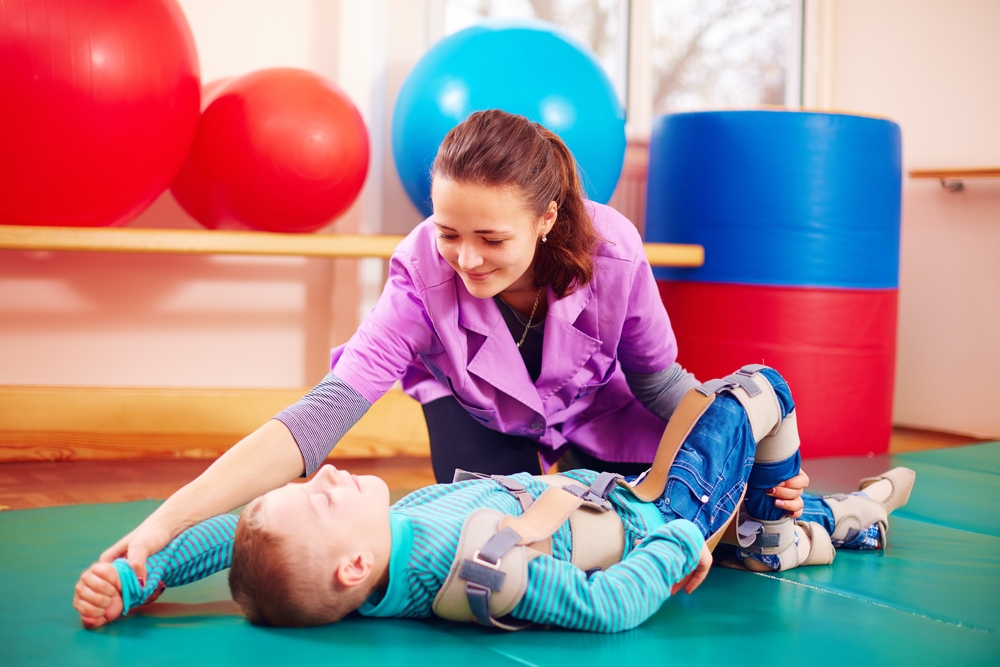Physical Therapy and Other Interventions May Prevent Motor Deterioration in Patients with Rett Syndrome, Case Report Finds
Written by |

Physical therapy and other medical interventions, together with daily support from family and caregivers, can help adults with Rett syndrome maintain or even regain their motor skills, and remain physically active, a case report reveals.
The report describes how reconstructive orthopedic surgery plus physiotherapy successfully treated a kneecap dislocation in a woman with Rett syndrome, fully relieving her from pain and enabling her to walk, even at a stage in her disease where recovery of movement was not expected.
With this report, researchers want to highlight the importance of preventing late deterioration in movement in adults with Rett syndrome, through timely assistance and with appropriate measures.
The study, “How reconstructive surgery combined with physiotherapy for a painful nontraumatic patellar dislocation enabled a woman with Rett syndrome to become pain free and remain physically active: A case report,” was published in the journal Clinical Case Reports.
Mental and physical disabilities due to Rett syndrome progress over the course of four stages:
- stage one – early stagnation (6 to 18 months old)
- stage two – rapid regression (1 to 4 years old)
- stage three – plateau or stationary phase (2 to 10 years old)
- stage four – late motor deterioration (from age 10 onwards).
The stationary phase (stage three) can start as early as two years of age and often lasts for several years. It is characterized by a relatively calm period during which some improvements can occur, including in behaviour (less irritability), communication, and better hand usage and body movement, even though other problems may emerge (such as abnormal muscle tone, contractures, and abnormal heart rhythms).
However, usually at around age 10, patients can start experiencing a worsening in their motor skills, with a reduction or loss of mobility — referred to as the late motor deterioration phase (stage four).
This period can last years or decades and commonly involves the development of a spinal curve, known as scoliosis, muscle weakness and stiffness, or losing the ability to walk.
“The purpose of the report is to highlight the importance of preventing a decline from the stable phase to the late motor deterioration stage with appropriate measures,” the researchers wrote.
This study describes the case of a 39-year old Swedish woman with Rett who was treated at The Swedish National Center for Rett syndrome & related disorders.
She developed a problem on her left knee in late adolescence, often experiencing a temporary and partial dislocation of her kneecap from its normal position in the groove of the thigh bone (femur). This problem affected her ability to flex her knee voluntarily, which strongly limited her mobility.
She had difficulty in walking over door sills, sitting, and sleeping. Additionally, her diseased knee was increasingly painful. A knee orthosis was tested, but it was determined to be unhelpful. This period was considered the beginning of stage four in her disease.
As the problem worsened in her mid‐thirties, the woman’s medical team proposed knee surgery to reduce her pain and help her regain the ability to walk. The surgery was carried out by a regional orthopedist two weeks after she started on targeted physiotherapy that was in agreement with her surgeon.
The program consisted of five to 10 repetitions of passive knee flexion and hip abduction (movement of the leg away from the midline of the body), twice a week, over the first two months, and once a week during the third and last months. The main goal was to increase the degree of knee flexion and hip abduction, and to recover the ability to walk. The woman’s family and caregivers also helped her perform the same exercises four times a day and encouraged her to walk.
Three months after surgery, she was able to bend her knee to 100° in a sitting position (she could move it to 30º before surgery) and to 80° in a lying position, while keeping her hip close to her body. Her hip extension also improved.
The woman had regained her ability to walk independently and on the treadmill.
Six months after surgery, she stopped experiencing any pain at night, was able to sit down and get up, while she maintained her joint motion and walking ability. The woman retains these abilities, four years later.
“According to her parents, she is mobile and can act independently, such as walking toward or away from an activity. She can actively flex her knee and sit down on a chair and get up again, walk on the treadmill and outdoors with gentle support,” the researchers wrote.
“In addition to the gross motor improvements, she is also pain free, more present in social contact and, overall, seems happier,” they added.
Placing a Rett patient within the so-called late motor deterioration phase can be misleading and even harmful, the researchers said.
“The stage might be taken as an unconditioned progressive phase of the syndrome leading to an expectation of motor deterioration in adulthood,” they stated.
Motor skills such as walking can deteriorate in any disorder due to secondary causes, such as orthopedic problems, poor health, and physical inactivity. Therefore, examining body structures and motor skills, individual therapeutic programs, and regular follow‐ups “are crucial throughout a patient’s entire life,” the study said.
Unfortunately, regular physiotherapy is rarely offered to adults with Rett syndrome. “This lack of physiotherapy in adulthood almost certainly affects those persons’ possibility to remain physically active,” the researchers wrote.
This case report illustrates how appropriate medical and physical therapy, combined with daily assistance by the patient’s support network, can significantly help Rett patients regain motor skills and remain physically active, and prevent an irreversible decline to the late deterioration stage.





